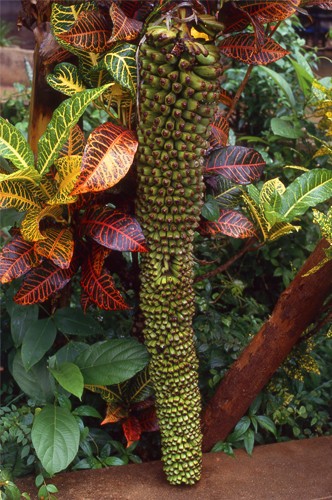Features on Asian Art, Culture, History & Travel
Archives
Archives > WORLD > Banana

Banana
The Bounteous Banana
SEE RELATED IMAGES @ PICTURES FROM HISTORY
"The Plantain I take to be the King of all Fruit,” - William Dampier, Voyages (1686)
Bananas have been around a long time, at least in the Old World of Asia, Africa and Europe. Quite where they originated remains uncertain. Some authorities favour West Africa, since the name "banana" is believed to have come from Guinea, via Spanish and Portuguese. In all probability, though, bananas – and their equally useful green cousins, plantains – originated in Asia, possibly in the Middle East. Certainly bananas are noted with approval in early Greek, Latin and Arab literature, and the name plantain is believed to derive from the Latin planta, "a spreading sucker or shoot". Alexander the Great saw – and no doubt tasted – bananas on his expedition to India in the third century BC., and they are mentioned in Chinese lists of Tang Dynasty exotica as pleasant fruits of nan-yang, or Southeast Asia, more than thirteen hundred years ago.
Shortly after the discovery of America, the banana was brought from the Canary Islands to the New World, where it was first established in the Island of Hispaniola. It soon spread to Central America and Brazil, where it thrived in the rich soil and warm climate. Nowadays bananas are a staple of many tropical economies, and so popular have they become with consumers in the temperate markets of North America, Europe and Northeast Asia that millions of tons are imported annually in custom-built refrigerator ships. It's strange to relate, but demand for bananas in Europe even played a role in the reunification of Germany – so anxious were the citizens of the former East that, when the Berlin Wall came down, they spent weeks scouring West German supermarkets for this symbol of consumer affluence!
By any yardstick the banana must rank as one of the most useful plants known to mankind. Yet what, precisely, is it? It looks like a fruit-bearing tree, but is in fact a giant herb which springs from an underground stem, known as a rhizome, to form a "false trunk" anything from three to seven metres high. In short, it's more like a stick of celery or a giant leek than a woody trunk. Bananas thrive naturally on deep, loose, well-drained soils in humid tropical climates, and they are easily cultivated with simple irrigation techniques in semi-arid regions. Within nine to fifteen months of planting, a large flower spike, bearing numerous reddish petals, emerges at the top of the false trunk and hangs downwards to become bunches of 50 to 150 individual fruits, known as fingers. These individual fruits are generally grouped in clusters known, appropriately enough, as hands. After a plant has fruited, it must be cut back to the ground, as each plant produces only one bunch of fruit in its life.
Desirable commercial bunches of bananas consist of nine hands or more and weigh 22-65 kg (49-143 pounds). Three hundred or more such bunches may be produced annually on one acre of land. The ripe fruit contains as much as 22 percent carbohydrate, mainly as sugar, and is high in potassium, low in protein and fat, and a good source of vitamins C and A. Though most commonly eaten fresh, bananas may be fried or mashed and chilled in pies or puddings. They may also be used to flavour muffins, cakes, or breads. In Africa and parts of Latin America green bananas, or plantains, are an important food staple, being boiled or fried and eaten in place of rice, potatoes, corn or bread. The flower, too, may be eaten when boiled – as indeed can the central stem of the false trunk, which provides a nutritious, if bland, base for some Southeast Asian curries. In short, just about everything about the banana which can be eaten, is eaten, at least somewhere in this world.
But that's just part of the story. Citizens of temperate countries may not know it, but those of the tropics certainly do. The leaves of the banana plant emerge from the head of the false trunk like so many tightly-curled cigars, opening to form huge, iridescent green fronds which provide plantation workers with welcome shade. The leaves have many practical uses, too. They provide temporary water-proof roofing, and are used as wrapping in steaming or barbecuing food. At a pinch, they can be used as clothing – certainly the fibrous elements of tougher leaves can be made into cord, and often in Africa banana leaves are pressed into temporary service as hats during monsoon downpours. In times past this use as clothing was certainly more widespread, as can be seen from the Latin name for the banana – Musa paradisaica, the banana of paradise. This derives from the early Oriental Christian belief that leaves from the banana tree were used by Adam and Eve to fashion aprons for themselves when they were cast out from the Garden of Eden.
The false trunk of the banana has its uses, too. When cut it is light and supple, and several tied together make a functional, if short-lived raft. In the Buddhist countries of Southeast Asia – notably Thailand, Burma, Laos and Cambodia – cross-sections of the trunk are carefully decorated, topped with incense, jasmine flowers and small coins, and floated in the rivers and lakes of the region each November to honour the Water Goddess and ensure the continuing course of the monsoon rains. Being naturally bio-degradable, they're environmentally friendly and perfect for this most beautiful of Southeast Asian ceremonies.
SEE MORE BANANA IMAGES @ PICTURES FROM HISTORY
Text by David Henley & Andrew Forbes; Photos by David Henley & Pictures From History - © CPA Media
